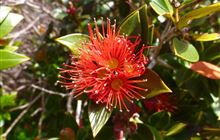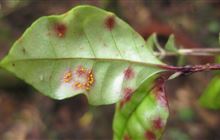Pōhutukawa
Introduction
Pōhutukawa is New Zealand's Christmas tree, and holds a prominent place in Maori mythology.Although the fortunes of pōhutukawa and rata have changed for the better, they are still threatened by people and pests.
Image gallery
New Zealand's Christmas tree
The blazing red flowers of pōhutukawa around Christmas time have earned this tree the title of New Zealand's Christmas tree. Pōhutukawa and rātā belong to the genus Metrosideros. In New Zealand, this genus is represented by two pōhutukawa (mainland and Kermadec), six species of rātā vine, a related shrub, and three tree rātā.
Mainland pōhutukawa (M. excelsa) occurs naturally in the upper half of the North Island (north of New Plymouth and Gisborne) although it grows from one end of the country to the other. It is easily distinguished from rātā by the hairs on the underside of the leaves.
Sacred trees
Pōhutukawa and rātā hold a prominent place in Maori mythology. Legends tell of the young Maori warrior, Tawhaki and his attempt to find help in heaven to avenge his father's death. He subsequently fell to earth and the crimson flowers are said to represent his blood.
Possibly the most famous pōhutukawa in Maori legend is a small, wind-beaten tree clinging to the cliff face near Cape Reinga. The 800-year-old tree is reputed to guard the entrance to a sacred cave through which disembodied spirits pass on their way to the next world.
Rātā was often respected for its immense size, which provided, among other things, shelter for weary travellers.
Threats to pōhutukawa and rātā
Possums
As possum populations have built up in forest areas, there has been a corresponding loss of some of our forest species.
Possums browse a wide range of plants but show strong preferences for some species like rātā and pōhutukawa.
Rātā and pōhutukawa trees cannot tolerate sustained possum browsing. A mature tree can be killed in three years with intensive browsing and even young trees, although they can survive for longer, will eventually die if browsed regularly.
When the browsed trees die back, the canopy, or top layer of the forest, is opened up. This exposes other trees to windthrow and damage from storms, insects, weed invasion, and diseases.
Myrtle rust
Pōhutukawa and rātā are members of the Myrtle family. They are all under potential threat from the fungal disease myrtle rust which is now established in New Zealand.
Other threats
Other threats include the following.
- People damage trees by using their branches for firewood, lighting fires under them and parking cars on their roots.
- Weeds and grasses often prevent regeneration by smothering young seedlings.
Our work
DOC works closely with other agencies such as Project Crimson to restore rātā and pōhutukawa habitat on the mainland through education and revegetation programmes.
DOC and other agencies also carry out sustained possum control operations. For rātā, the operations cover large areas of northern and southern rātā dominated forests of mainland New Zealand. For pōhutukawam, work continues in main coastal sites within the natural range of pōhutukawa (Northern North Island).
With myrtle rust, there is ongoing research and monitoring to determine what impact the disease will have on our native tree species.
All this work will help ensure the ongoing survival of these important iconic forest species.




